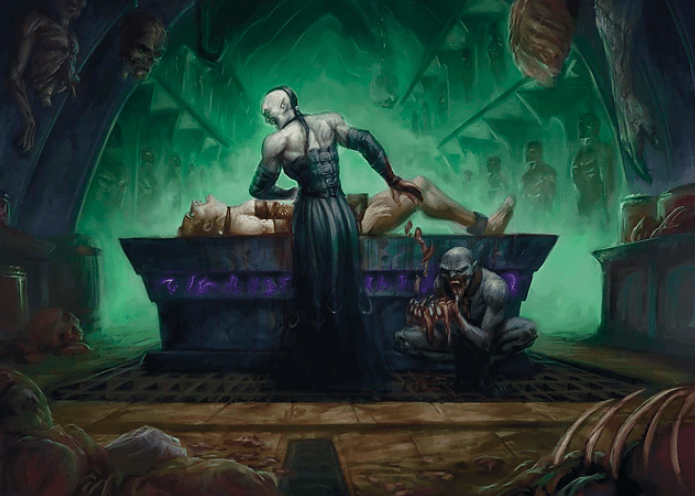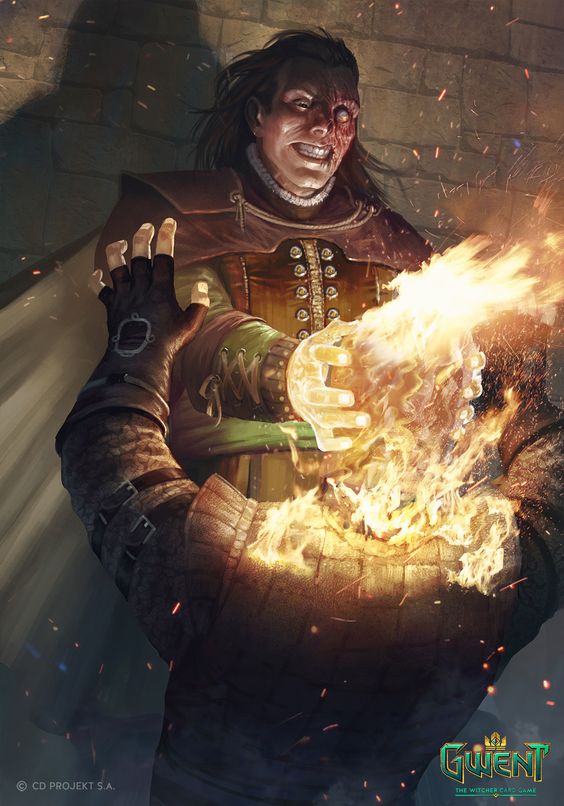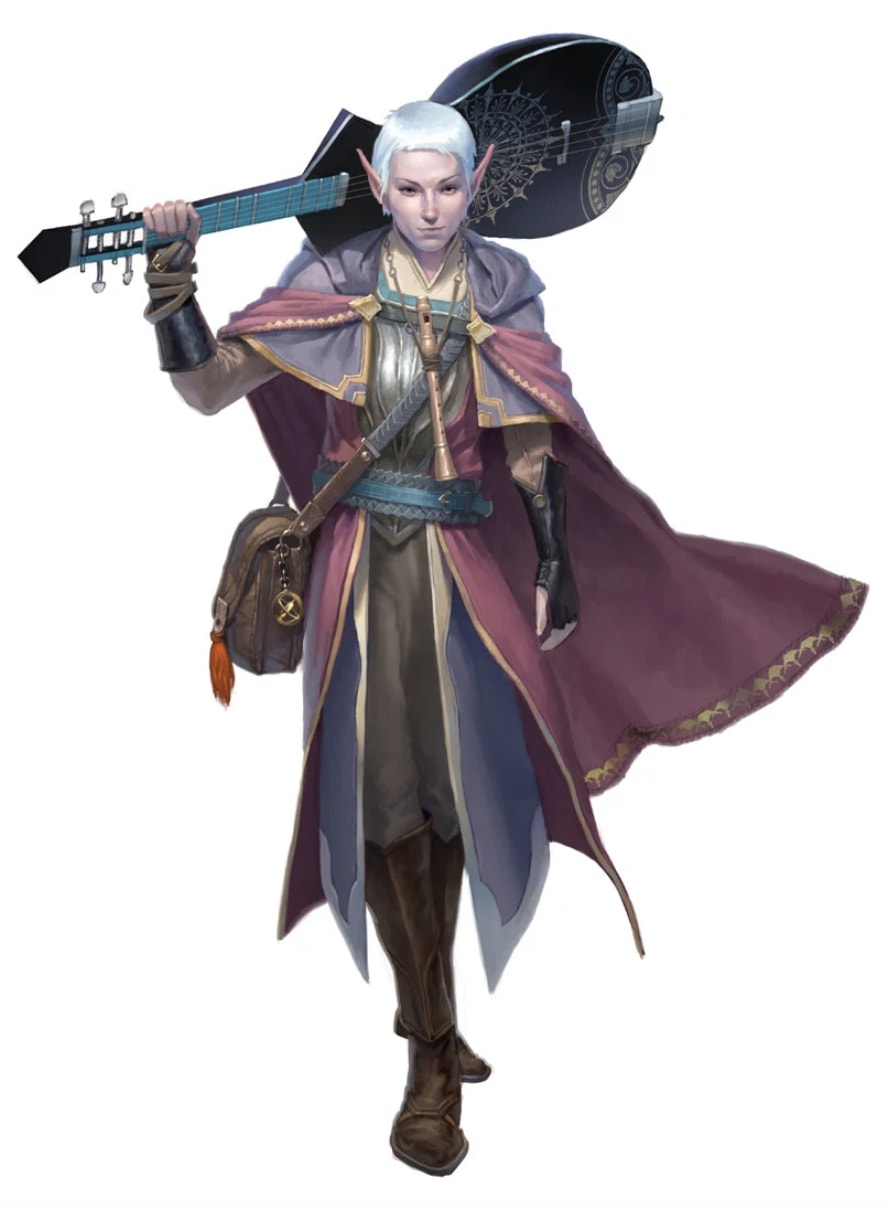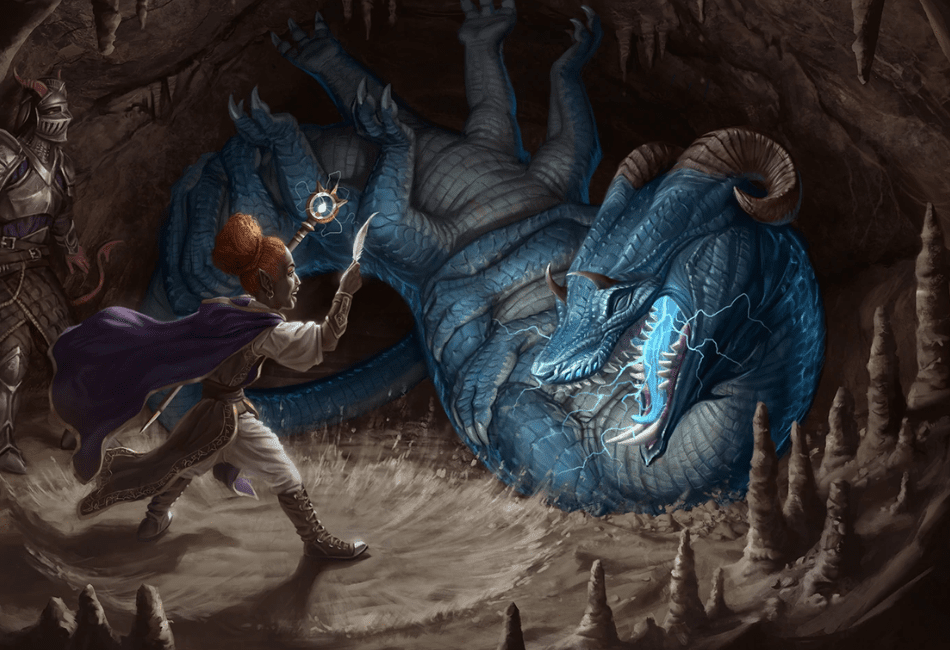The great orc siege is coming. The battle will start by dawn, and your party prepares the camp with the rest of the recruits. The Warlock made some dummies to fool the enemy, the Wizard and the Fighter helped with the fortifications, and the Monk and the Ranger scouted ahead to set traps. As a good bard, you’ve been playing the lute.
The battle starts with a huge run from the orcs, passing through the field. Your ranged attacks help to lower their numbers, but they are not enough. The ogres start to whack on the front gate, and you feel the earth tremble as the walls collapse. The ogres walk forward as the orcs rush inside, followed by their leader. The orc leader is prominent and robust, with a commanding presence and a rugged look.
You know incapacitating the leader will break the attack’s resolution and order. You start playing your lute, and the battlefield seems to silence for a second as you say a very stupid joke about elves and poop. Your elvish companions eye you angrily, and some orcs return to attack. However, you accomplished your goal. The commander falls to the ground in laughter, and everyone around him is confused.
The rest of the battle goes your way, as the orcs lose order and the ogres are defeated with a barrage of spells. Lastly, the orc leader is left alone, laughing on the ground, ready to be whaled by the entire camp.
Welcome to a Tashas Hideous Laughter 5e Guide..
How does Tasha’s Hideous Laughter work?
“Tasha’s Hideous Laughter” (THL) is a 1st level enchantment spell located in the PHB (Player’s Handbook) on page 280. The casting time is one action, the range is 30 feet, and the duration is up to 1 minute with concentration. The components are Verbal, Somatic, and Material. The effect is as follows:
“A creature of your choice that you can see within range perceives everything as hilariously funny and falls into fits of laughter if this spell affects it. The target must succeed on a Wisdom saving throw or fall prone, becoming incapacitated and unable to stand up for the duration. A creature with an Intelligence score of 4 or less isn’t affected.
At the end of each of its turns, and each time it takes damage, the target can make another Wisdom saving throw. The target has advantage on the saving throw if it’s triggered by damage. On a success, the spell ends.”
Breaking down the spell’s characteristics

The first-level spells are where the real magic in DND begins. Here is where the bread and butter of many casters lay from early to mid-game. At this level, you need to compare THL to spells like Find Familiar, Shield, Bless, Magic Missiles, etc. They are all spells of low power but just enough to be envied by any non-casters. The effect of THL is very similar to the second-level spell “Hold Person,” which hints at a potent spell at these levels of play.
The spell is enchantment because it affects the mind directly. Nonetheless, it is good to point out that magic is still at play. No matter how serious the enemies are, they will laugh if they fail the save.
Sometimes it feels that if you’re not doing damage with your action, you’re wasting it. However, this is not the case for THL. The spell incapacitates a creature and makes it go prone. This effect alone is beneficial. It won’t kill anybody, but the warrior will be thankful for the advantage on attacks. Besides, it is excellent for boss encounters to keep them from using those big guns for some rounds.
The range of 30 feet is short, but it’s a low cost for such an effect. Many creatures can only attack at melee range, so if you’re smart, they will fall before they can get to you. Also, it’s good to keep in mind that you can hold your action to cast it as a reaction when the enemy gets in range.
The duration of one minute is essentially an entire combat encounter. Needless to say, it is fantastic to potentially remove a threat from the battlefield for the whole thing: one less spell caster or giant monster to worry about. Most spells with a one-minute duration are the ones with an effect that gets better with each round that they are active. In this case, each time the enemies fail their save, they immediately lose an entire turn. Therefore, anything you can use to prevent the creature from saving is excellent. Things like Bane or Bestow Curse are great options.
One of the considerable limitations of this spell is its concentration requirement. Spells with concentration can be ended sooner if you are not careful. Once you lay down this spell, try to get out of harm’s way, or the effect will eventually wear off sooner. This limitation also prevents you from having more than one concentration effect simultaneously. In this regard, always balance out the possible uses of this resource.
The other significant limitation of the spell is the requirement of all components. This means you have to be able to speak, use your hands, and have a material component or a spellcasting focus. Most of the time, these limitations won’t come into play, but when they do, you’re screwed. Finding a safe spot to cast this spell also means being able to throw it in the first place.
Breaking Down the Spell’s Effect

There are multiple things in play when this effect goes off:
- You must be able to see the objective: This tends to be the default for any single target spell. This simple limitation means you can’t target any invisible or hiding creature.
- The enemy makes a Wisdom Saving Throw: This is the most common saving throw for mind-affecting effects. A Wisdom Save is made to notice something off, to see through an illusion, or to resist another will trying to twist your own. Giant strong creatures do not mightily resist this saving throw, but it may be prevalent for nature-related intelligent creatures, like druids or treants. Most intelligent creatures also tend to have good Wisdom.
- Falling prone and unable to stand up: Most effects that incapacitate a creature add something else. This is the case for THL. The spell makes that character a crawling slug, halving their speed and having it receive all melee attacks at advantage. One more thing about this effect comes to play against flying creatures. When a flying creature (who doesn’t hover) falls prone, they fall to the ground, receiving falling damage. This simple fact makes the spell exceedingly effective against aerial monsters.
- Incapacitate: When a creature is incapacitated, it can’t take any actions or reactions. This includes bonus actions but not the movement. So the only thing the target can do is crawl in despair while laughing at its suffering. This is the main appeal of the spell, and it stays good through all levels of play.
- Only five or higher intelligence applies: This limitation seems small, but it isn’t. There are many monsters in DND with low intelligence. The spell is useless against many undead, constructs, oozes, monstrosities, and especially beasts. With this in mind, the spell is much better in a city than in the wilderness.
- Repeated Wis Save: This is the other consideration with the spell. There are only two ways to end it. Either the caster loses concentration, or the target makes a successful save.
The rest of the party must know that it will have another save with advantage whenever they attack the creature. Because of this, the best way to use the spell is to leave the target on the ground while you and your team get rid of their allies, and only then do you destroy that poor prone creature.
When you have a powerful foe pinned down by a spell like this, it’s essential to get out of harm. There are many ways you can augment your capability to survive, but some of the best are: Going invisible, if you’re a Druid, wild shape into a high Con beast, flying, having War Caster or Resilient feat, etc. These apply to almost all spells that have concentration.
Who’s Funny Enough?

Tasha’s Hideous Laughter is a 1st level spell available in the Bard and Wizard spell lists on page 276 of the Player’s Handbook. The spell is available for any character with access to those spell lists: Eldritch Knights, Arcane Tricksters, Aberrant Mind Sorcerers, etc. It’s also on the expanded spell lists of the Great Old One Warlock. Lastly, it can be taken by ANY character at the fourth level with the “Magic Initiate” feat.
…Continue reading to learn more about the Magic Initiate Feat
Not many creatures in the game’s Manuals have this spell at their disposal. Nonetheless, as a DM, you can add any spell you want to a stat block if you think it’s appropriate. For any Dungeon Masters who want to use a stat block with this spell, here’s a brief list you can consider:
- Monsters: Cloud giant Smiling One, Nilbog, Spring Eladrin, Deathlocks of the Great Old One.
- NPC: Warlock of the Great Old One
How to Have the Last Laugh
There are spells with open-ended intentions, like Mayor Illusion or Polymorph, but that’s not the case with Tasha’s Hideous Laughter. THL is a combat-oriented cantrip. Yes, you could use it outside of combat, and we’ll discuss some of its alternatives uses. However, its primary purpose is to be used in combat as an incapacitation tool. And it’s a great tool at that.
There are many things to remember to use this spell correctly, and there are probably many more than I can recall. However, here are some tips:
Choose the right target:
- Take down the main threat: The spell is a tool to remove dangers from the battle and is very effective. However, you need to remember that if you attack the creature, it’ll eventually make the Save. The best target is the one with the highest damage output or great battlefield control. Some examples are the enemy spellcasters, ranged attackers, and terrifying weapon wielders.
- Avoid meat shields: There are two problems with using this spell on gargantuan bags of hit-points. The first is the possibility of low intelligence. Some huge, terrifying creatures like the Remoraz or the Owlbear are so dumb that you can’t affect them. The second is that the biggest threat is not always the one that does more damage, but it’s probably the one that’ll last the longest.
- Single-enemy encounters are a park walk: This spell is incredibly potent if there is just one enemy. It doesn’t matter now if they are a spell caster or not. They are the ONLY threat. With this spell, you can leave the enemy on the ground, ready to be obliterated at melee range by your party.
- Dummies are often unwise: Although I said that you should avoid big creatures, there is the exemption with hulking humanoids. Creatures with mid to low intelligence, like ogres or goblinoids, usually have low Wisdom Scores, which means they are unlikely to make the Save.
- Flying and swimming creatures have a bonus: I’ve said it already, but I’ll repeat it. If a flying creature that doesn’t hover falls prone, it’ll receive extra damage. This can wake them up, but they’ll be on the ground. Furthermore, if a creature is swimming, it can potentially drown in laughter. The rules don’t specify a situation like this, but a person underwater who starts to laugh would probably drown very fast. Also, there is no “drowning damage,” so they could go down without even making saving throws with advantage.
Choose the right time:
- The earlier, the better: As with all spells with more than one round of duration, the more the effect is in play, the more the impact it has in battle. If you can deduce early on what’s the most significant threat on the battlefield, take it down before they get to act, and you’ve severely hindered the enemies’ capabilities.
- Cut-off setups: When an enemy uses an action to do something without an immediate repercussion, they are probably setting up the most dangerous turn. That’s a great moment to strike. You can potentially render their last, as well as their next, useless. This includes when an enemy uses a defensive buff like Mirror Image or Blight.
- Awkward positions: If an enemy finds itself in the wrong spot, this spell could pin it down where they don’t want to be. If they are fleeing the battle or in the middle of a war zone, you can make them laugh at their unfortunate. It is better to pair with holding an action to cast during the enemy’s turn. Imagine casting this spell while the enemy is jumping between buildings.
The Fun and the Torture. Flavor Your Spell

We’ve seen that this spell is not hard to get, meaning that it can have a lot of variations depending on the caster. When we first think of THL, the typical image that comes to mind is the Bard joking around and making people laugh. This is probably the most familiar scene where this spell is cast. However, it was never its intention to be funny.
Before we get into all the possible variations of the spell, I’d like to take a step back and recount the history around this spell and even more about its creator.
Tasha, Iggwilv, and How This Spell Was Born
Natasha was a human girl raised by Baba Yaga, probably the most powerful witch ever. From very early in her life, Natasha was a natural at magic and quickly learned the teachings of her mentor. She created the spell when she was still a young mage with the nickname of Tasha.
Remember, the mentor of Tasha was non-other than the terrible Baba Yaga. Her magic was putrid and scary, not delightful and funny. Tasha’s Hideous Laughter is also known as Tasha’s Uncontrollable Hideous Laughter. It was meant to be torture. It’s like when your big brother wrestles you to the ground and starts to tickle you. Like that, but it never stops. Think of Tasha as the Joker and his laughing gas. She wanted to make people suffer while laughing.
After these young and innocent life moments, Tasha got further into the evil side of the Universe. She lived in the Abyss and Hades for many years and even had romances with demon lords. Once she got older, however, she got tired of pure evil, went into the Feywild, and enslaved many creatures into her dominion. Nowadays, she is trapped in a temporal stasis set by some of her step-sisters.
In resume, THL wasn’t created by a comedian but rather a wretched hag with an insatiable need for knowledge. Nonetheless, this spell grew to be what it is today after being used as a security measure in many places of Waterdeep and learned and improved by magicians over time. As with many jokes, it started as a tragedy, and with time…
The Fantasy of THL
Although the spell includes “Hideous” in its name, it has become one of the funniest 1st-level spells in the game. It’s the little brother of “Otto’s Irresistible Dance,” a 6th-level spell that does the same as THL but much better. Nowadays, the spell has mainly two type of casters:
- The evil enchanters: These are the ones that follow the path of Tasha and use this spell as a powerful way to incapacitate an enemy, torturing them with laughter. They usually appear in grim-dark campaigns or as villains.
- The comedic bards: These are the ones that use this spell in conjunction with bad jokes on the table to laugh. They appear in most campaigns and especially in joke characters. Here’s an example of the type of jokes you can find.
Open Up the Spectrum
Alright, now that we’ve seen the intention of the spell as well as its evolution and current state. Let’s open our minds and get creative. One thing that makes DND and all role-playing games splendid is the possibility to flavor your character as you see fit. We’ve seen the most common ways of using this spell, but now I’d like to give you some tips on how to make your own THL:
Components:
This spell has three parts: Verbal, Somatic, and Material. Spells with these have mechanical limitations, as we’ve discussed. But with any restrictions come opportunities. The rules leave open interpretations on how you’re supposed to move or speak to cast spells:
- Somatic: How you move can be as subtle or exaggerated as you want. You can even change the ways you cast the spell each time. You can make a hilarious dance or a typical finger weaving in the air as a somatic component. If you cast this spell after moving, you can say that you’ve tripped and rolled back, Chaplin’s style, to get a laugh.
- Verbal: This is the typical bad joke. You can make a dad joke, a “knock knock” joke, a One-liner, etc. everything goes… just try to avoid cringy repetition. You can mix jokes with simple gibberish incantations or anime attack naming. Just find something that you feel comfortable with.
- Material: The materials in the spell’s description are optional; they are the “normal way” the spell is cast in the world of DND, but you can reinvent them. You can wave the feather “tickling” the target from a distance or have a pouch of velvet bean teleported inside the enemy’s clothes.
- Arcane Focus: Sometimes, you can use a spellcasting focus instead of the material components. In this case, you can have any item you want as a spellcasting focus if your class allows it. You could play the intro of “El Chavo del Ocho” in your flute, and that’s how your spell is cast.
Origin:
Your character learned the spell from a source. It could have been your own spell list, or you could have learned it from a spell scroll, a subclass ability, or a magic Item. Besides the standard types, here are some examples of other origins:
- Aberrant Mind Sorcerer: The spell is a manifestation of your own emotions. Perhaps you laugh yourself before the enemy does. This can be a reinterpretation of the typical “contagious laughter” some people have.
- From the Demonomicon: The Demonomicon is an artifact crafted by Iggwilv herself. It has powerful demonic energy coming from inside. When you cast this spell from it, perhaps spectral hands pop out of the ground and start tickling the target and grabbing them to the ground.
Character:

Lastly, you can forgo how the spell is learned or how it’s supposed to be cast and bring the spell directly from your character’s personality. With a spell that you can grab with Magic Initiate, your character can be anything you want, so here are a few examples that pop into my mind:
- A Druid dipping into Bard: You can be a Satyr that grows itching vines around the target, making it fall into a burst of painful laughter.
- An Arcane Trickster: This is very easy because you can just flavor the spell by using your invisible mage hand to tickle the enemy.
- A Cleric dipping into Wizard: Maybe you’re a doctor whose knowledge of human physiology and anatomy grants them the capability to magically touch the enemies’ “weak spots” and make them fall to the ground laughing.
FAQs
Question: How can I counter Tasha’s Hideous Laughter?
Answer: As well as with all spells in the game, you can counter it by taking away the capability of using the components of the spell. In the case of Hideous Laughter, you can avoid it by restraining the caster’s hands, silencing them, or destroying or robbing its material component. It is also a concentration spell, so an ally can end the effect by punching the caster. Lastly, you can find a way to make the caster use the spell on the character with the highest Wisdom Save. You can bluff, provoke, or find another way to trick the enemy.
Question: Does Tasha’s Hideous Laughter count as a charming effect?
Answer: No, Tasha’s Hideous Laughter doesn’t count as a charming effect for any effect that needs a charming condition. For example, any creature with immunity to charming effects can still be affected by this spell, or any ability that grants you advantage on saves against charming wouldn’t work with this spell.
Question: Is a creature affected by Tasha’s Hideous Laughter if they can’t laugh?
Answer: Yes, if the creature has at least five intelligence, it can get affected. This is the case for the skeleton, for example. Here’s a tweet from Jeremy Crawford that can help clarify these situations.
https://twitter.com/jeremyecrawford/status/950169871903481856
In Conclusion: Do I Make My Enemies Cry with Laughter?
Tasha’s Hideous Laughter is a great spell, probably the best low-level, single-target removal in the game. It can end a combat encounter by itself and is helpful through all levels of play in one way or another.
It can be funny, it can be terrifying, and it can make your DM really mad. If you have access to this spell and you think it fits with your character, by all means, take it, and have fun!
- Shadow Blade 5e Guide: The Edgy Sword - October 31, 2022
- Aid 5e Guide: Free Points! - October 1, 2022
- Flaming Sphere 5e Guide: Running Orb of Fiery Chaos: - October 1, 2022

